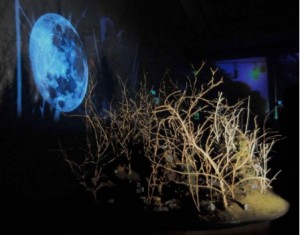February 5, 2010
At the Aldrich, the sky’s the limit with new geocache exhibit
By Deb Keiser
RIDGEFIELD — Five new exhibits opened at the Aldrich Contemporary Art Museum last weekend, and while one zooms in on museum interiors (the unseen views), another shows us that in art, the sky’s the limit. All in all, the exhibitions remind us that surprising artistry can be found in unexpected places.
In “Sleeping Under Stars, Living Under Satellites,” media artists Jeanne C. Finley and John Muse present a multi-pronged show that explores time and space through the rhythms of daily life. Finley and Muse have focused on the paths of today’s Ridgefield residents, as well as on those from the past, such as a wandering vagrant known as the Leatherman, and hermit Sarah Bishop.
The Aldrich Museum in Ridgefield, CT. had an opening of Five new exhibits on Sunday, Jan. 31, 2010.

Among the exhibits isSleeping Under the Stars, Living Under the Stars by Jeanne C. Finley & John Muse. The exhibit is an unusual video installation in the dark.
The leatherman (known as such for his 60-pound handmade, animal-skin suit) completed a 365-mile clockwise circuit through part of New York and Connecticut every 34 days between 1856 and 1889. Bishop was a woman who lived in a small cave between Ridgefield and North Salem after the Revolutionary War; she resided there for more than 30 years.
Stories of the Leatherman and Bishop, set against a contemporary event — Ridgefield’s 300th anniversary parade on July 4, 2008 — are told in this exhibit through a variety of media, including multichannel video projection, sculptural elements, and geocaches — online, GPS-driven treasure hunts (see box).
In entering the dark gallery that recalls Bishop’s cave, the visitor is quieted and attention goes first to the video projection on three walls of the space. There the parade route is shown, using a stop-action technique that recorded the events on Main Street that day over a 24-hour period. The parade is revealed as only a part of the day and daily rhythm of Ridgefield and its residents.
Simultaneously, a swirling overlay of video images and shadows circle the room, and a voice-over explains the historical aspects of the lives of the Leatherman and Bishop. The exhibit overlays the past on the present and lets the viewer interact with the subject in his own way. The effect is magical and results in an introspective and soothing break from our own daily rhythms, and the realization that now the satellites have become new stars.
Think about it: The hermit’s life was based on the changing seasons, the vagrant ticked off time through his regimented wandering, and the days of today’s residents are marked and guided by the minutes and seconds of hand-held devices — from cell phones to the GPS.
Visitors can become even more engaged with the exhibit by going outside the museum and finding the three geocaching circuits the artists have created nearby, bringing past and present together again. (More information on this is available at the museum.)
“We want people to experience the work,” said Finley. “Allow yourself to feel the rhythms of the piece. See how it intersects with your own life.” Finley and Muse have collaborated on projects for more than 20 years. This is their first major project in the Northeast.
In “Chad Kleitsch: White Box — Photographs of the Unseen Museum,” Chad Kleitsch uses his camera to take us behind the scenes during museum “show changes” — a time after the art has arrived, but before the show has opened.
“In a way, the show change is like a construction site, and people want to peek. Their curiosity should be fulfilled,” Kleitsch said.
His photographs of artworks propped against gallery walls and wrapped in blankets inside large empty galleries reveal the complex relationship between art and the space in which it is presented. Visitors must reconsider the objects in unusual situations.
“I hope to get people to see museums in a different way, to re-engage people,” said the artist. “To make people more present is the goal of the project.”
The project began in 2001, when Kleitsch began to ask museums for open access with his camera during exhibition changes, and it has now encompassed more than 14 museums and nonprofit exhibition spaces, including The Aldrich, The Metropolitan Museum of Art, and The Museum of Modern Art.
The three other exhibits, “Paying a Visit to Mary,” “Ocular Visions,” and “Tom Molloy” round out the experience with an avant-garde approach to projects that focus on communication, vision and American politics, respectively.
Tom Molloy, an Irish artist, in his best-known work, “Map,” cuts a tiny world map out of a dollar bill. In “Dream,” he manipulates the image of Barack Obama on the cover of two paperback books so that the president’s skin appears to be white. Joseph R. Wolin, curator of the exhibit, writes, “We can easily find the gesture mocking and disturbing, seeming to play into the racial prejudices of both those who would prefer a white commander in chief and those who consider the president `not black enough.’ “
As always, the Aldrich has succeeded in providing exhibits that engage and stimulate in different and fascinating ways.
The Aldrich Contemporary Art Museum is at 258 Main St. in Ridgefield; these new exhibits run through June 6. For more information, go to www.aldrichart.org or call 203-438-4519.
